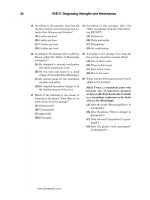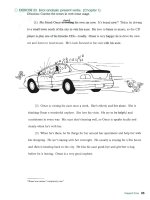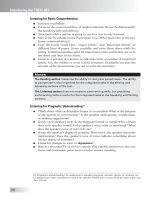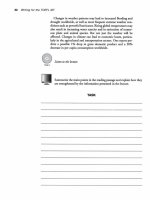Oganization struture questions 6 pps
Bạn đang xem bản rút gọn của tài liệu. Xem và tải ngay bản đầy đủ của tài liệu tại đây (65.81 KB, 6 trang )
of it. (4) In winter this pond was frozen over, and he
had taken his daughter Abigail there when she was
small and tried to teach her how to skate. (5) She
hadn’t been able to catch on, and so after two or
three lessons Abigail and him had given up the idea.
(6) Now there came into his mind an image of such
clarity it caused him to draw in his breath sharply;
an image of Abigail gliding toward him on her new
Christmas skates, going much faster than she should
have been.
23. Which of the following changes needs to be
made to the passage?
a. Part 6: Change the semicolon to a colon.
b. Part 4: Remove the word and.
c. Part 3: Change the semicolon to a comma.
d. Part 5: Change the comma to a semicolon.
24. Which of the following changes needs to be
made to the passage?
a. Part 4: Remove the comma after over.
b. Part 6: Replace Christmas with christmas’.
c. Part 5: Change him to he.
d. Part 3: Replace their with there.
Questions 25–27 are based on the following passage.
(1) If a building is to be left in a safe condition after
a fire is extinguished, firefighters must search for
hidden fires that might r
e-ignite. (2) Typically this
process known as overhaul, begins in the area of
actual fire involvement. (3) Before searching for hid-
den fires; however, firefighters must first determine
the condition of the building.
(4) The fire’s intensity and the amount of water
used to fight the fire are both factors that affect a
building. (5) Fire can burn away floor joists and
weaken roof trusses. (6) Heat from the fire can
weaken concrete and the mortar in wall joints; heat
can also e
longate steel roof supports. (7) Excess
water can add dangerous weight to floors and walls.
(8) Once it has been determined that it is j
ust
fine to enter a building, the process of overhauling
begins. (9) Firefighters can often detect hidden fires
by looking for discoloration, peeling paint, cracked
plaster, and smoke emissions; by feeling walls and
floors with the back of the hand; by listening for
popping, cracking, and hissing sounds; and by using
electronic sensors to detect heat v
ariance.
25. Which of the underlined words or phrases in the
passage should be replaced by more effective or
appropriate words?
a. just fine
b. heat variance
c. elongate
d. re-ignite
26. Which of the following numbered parts contains
nonstandard punctuation?
a. Part 8
b. Part 6
c. Part 9
d. Part 3
27. Which of the following changes needs to be
made to the passage?
a. Part 2: Insert a comma after process.
b. Part 9: Remove the comma after paint.
c. Part 6: Replace the semicolon with a comma.
d. Part 9: Replace all the semicolons with
commas.
Questions 28 and 29 are based on the following passage.
(1) The Competitive Civil Service system is designed
to give candidates fair and equal treatment and
ensure that federal applicants are hired based on
objective criteria. (2) Hiring has to be based solely on
a candidate’s knowledge, skills, and abilities (which
you’ll sometimes see abbreviated as KSA), and not
on external factors such as race, religion, sex, and so
– THEA PRACTICE EXAM 3–
265
on. (3) Whereas employers in the private sector can
hire employees for subjective reasons, federal
employers must be able to justify his decision with
objective evidence that the candidate is qualified.
28. Which if the following numbered parts lacks
parallelism?
a. Part 2
b. Part 3
c. Parts 2 and 3
d. Part 1
29. Which of the following numbered parts has an
error in pronoun agreement?
a. Part 1
b. Part 2
c. Part 3
d. Parts 2 and 3
Questions 30–32 are based on the following passage.
(1) Heat exhaustion, generally characterized by
clammy skin, fatigue, nausea, dizziness, profuse per-
spiration, and sometimes fainting, resulting from an
inadequate intake of water and the loss of fluids. (2)
First aid treatment for this condition includes hav-
ing the victim lie down, raising the feet 8–12 inches,
applying cool, wet cloths to the skin, and giving the
victim sips of salt water (1 teaspoon per glass, half a
glass every 15 minutes) over the period of an hour.
(3) ______________________________________.
(4) Heat stroke is much more serious; it is an
immediate life-threatening condition. (5) The char-
acteristics of heat stroke are a high body temperature
(which may reach 106° F or more); a rapid pulse;
hot, dry skin; and a blocked sweating mechanism.
(6) Victims of this condition may be unconscious,
and first aid measures should be directed at cooling
the body quickly. (7) Heat stroke often occurs in
poor people in urban areas. (8) The victim should be
placed in a tub of cold water or repeatedly sponged
with cool water until his or her temperature is low-
ered sufficiently. (9) Fans or air conditioners will also
help with the cooling process. (10) Care should be
taken, however, not to chill the victim too much
once his or her temperature is below 102° F.
30. Which of the following sentences, if inserted into
the blank numbered Part 3 in the passage, would
best aid the transition of thought between the
first and second paragraph?
a. Heat exhaustion is a relatively unusual condi-
tion in northern climates.
b. The typical victims of heat stroke are the poor
and elderly who cannot afford air condition-
ing even on the hottest days of summer.
c. Heat exhaustion is never fatal, although it can
cause damage to internal organs if it strikes an
elderly victim.
d. Air conditioning units, electric fans, and cool
baths can lower the numbers of people who
suffer heat stroke each year in the United
States.
31. Which of the following numbered parts draws
attention away from the main idea of the second
paragraph of the passage?
a. Part 6
b. Part 10
c. Part 8
d. Part 7
32. Which of the following numbered parts contains
a nonstandard sentence?
a. Part 8
b. Part 1
c. Part 5
d. Part 3
– THEA PRACTICE EXAM 3–
266
Questions 33 and 34 are based on the following passage.
(1) Theodore Roosevelt w
ere born with asthma and
poor eyesight. (2) Yet this sickly child later won fame
as a political leader, Rough Rider, and hero of the
common people. (3) To conquer his handicaps,
Teddy trained in a gym and became a light-weight
boxer at Harvard. (4) Out west, he hunted buffalo
and ran a cattle ranch. (5) He was civil service
reformer in the east and also a police commissioner.
(6) He became President McKinley’s Assistant Navy
Secretary during the Spanish-American War. (7)
Also, he led a charge of cavalry Rough Riders up San
Juan Hill in Cuba. (8) After achieving fame, he
became Governor of New York and went on to
become the Vice-President.
33. Which of the following sentences represents the
best revision of Part 5?
a. Back east he became a civil service reformer
and police commissioner.
b. A civil service reformer and police commis-
sioner was part of his job in the east.
c. A civil service reformer and police commis-
sioner were parts of his job in the east.
d. His job of civil service reformer and police
commissioner were his jobs in the east.
34. Which of the following should be used in place
of the underlined verb in Part 1 of the passage?
a. will be
b. are
c. is
d. was
Questions 35 and 36 are based on the following passage.
(1) Charles Darwin was born in 1809 at Shrews-
bury England. (2) He was a biologist whose famous
theory of evolution is important to philosophy for
the effects it has had about the nature of man. (3)
After many years of careful study, Darwin attempted
to show that higher species had come into existence
as a result of the gradual transformation of lower
species; and that the process of transformation could
be explained through the selective effect of the nat-
ural environment upon organisms. (4) He con-
cluded that the principles of natural selection and
survival of the fittest govern all life. (5) Darwin’s
explanation of these principles is that because of
the food supply problem, the young born to any
species complete for survival. (6) Those young that
survive to produce the next generation tend to
embody favorable natural changes which are then
passed on by heredity. (7) His major work that con-
tained these theories is On the Origin of Species writ-
ten in 1859. Many religious opponents condemned
this work.
35. Which of the following corrections should be
made in punctuation?
a. Part 4: Insert a comma before and.
b. Part 3: Delete the comma after study.
c. Part 2: Insert quotation marks around nature
of man.
d. Part 1: Insert a comma after Shrewsbury.
36. In Part 7 On the Origin of Species is italicized
because it is
a. a short story.
b. the title of a book.
c. the name of the author.
d. copyrighted.
– THEA PRACTICE EXAM 3–
267
Question 37 is based on the following passage.
(1) Herbert was enjoying the cool, bright fall after-
noon. (2) Walking down the street, red and yellow
leaves crunched satisfyingly under his new school
shoes.
37. Which of the following is the best revision of the
passage?
a. Herbert was enjoying the cool bright fall after-
noon. Walking down the street red and yellow
leaves crunched satisfyingly under his new
school shoes.
b. Herbert was enjoying the cool, bright fall
afternoon. He was walking down the street,
red and yellow leaves crunched satisfyingly
under his new school shoes.
c. Herbert was enjoying the cool, bright fall
afternoon. Walking down the street, he
crunched red and yellow leaves satisfyingly
under his new school shoes.
d. Herbert was enjoying the cool, bright fall
afternoon. Walking down the street, red and
yellow leaves were crunched satisfyingly under
his new school shoes.
Questions 38–40 are based on the following passage.
(1) The building in which Howard Davis was to
teach his undergraduate evening course, Interpreta-
tion of Poetry, was Renwick Hall, in the General
Sciences Building. (2) Markham Hall, which housed
the English Department offices and classrooms, was
to be closed all summer for renovation.
(3) Howard’s classroom was in the basement.
(4) The shadowy corridor that le
d back to it was
lined with glass cases containing exhibits whose titles
r
ead, “Small Mammals of North America,”“Birds of
the Central United States,” and “Reptiles of the
Desert Southwest.”(5) The dusty specimens perched
on little stands; the
ir tiny claws gripped the smooth
wood nervously. (6) A typewritten card, yellow with
age, bearing the name of its genus and species. (7)
The classroom itself was outfitted with a stainless
steel sink, and behind the lectern loomed a dark-
wood cabinet through whose glass doors one could
see rows of jars, each holding what appeared to be an
animal floating in a murky liquid. (8) The class-
room w
reake
d of formaldehyde.
38. Which of the following sentences, if inserted
between Parts 6 and 7, would best fit the author’s
pattern of development in the second paragraph
of the passage?
a. Howard would be teaching Byron, Shelley,
and Keats this term.
b. In the display case opposite Howard’s class-
room, a pocket gopher reared up on its hind
legs, staring glassy-eyed into the open
doorway.
c. Although Markham was at least twenty-five
years younger than Renwick, the administra-
tion had chosen to renovate it rather than the
aging, crumbling science building.
d. Genus and species are taxonomic categories.
39. Which of the following numbered parts contains
a nonstandard sentence?
a. Part 2
b. Part 7
c. Part 1
d. Part 6
40. Which of the underlined words in the passage
needs to be replaced with its homonym?
a. led
b. their
c. read
d. wreaked
– THEA PRACTICE EXAM 3–
268
Section 3: Writing (Part B—
Writing Sample)
Carefully read the writing topic that follows, then pre-
pare a multiple-paragraph writing sample of 300–600
words on that topic. Make sure your essay is well-
organized and that you support your central argument
with concrete examples.
American students are said to have fallen behind in
the sciences, and some educators believe it is because
American teachers are conducting science classes
ineffectively.
Write an essay in which you suggest ways sci-
ence classes could be conducted so as to more effec-
tively challenge high school and college students.
– THEA PRACTICE EXAM 3–
269
Answer Explanations
Section 1: Reading
1. b. The author describes in paragraph 1 how glam
rock musicians were characterized by their
flashy hair and makeup, and refers to their music
as a product, as if it was something packaged to
be sold. The choice that best describes a musi-
cian who puts outward appearance before the
quality of his or her music is choice b, style over
substance.
2. c. Ostentatious is an adjective that is used to
describe someone or something that is conspic-
uously vain, or showy. There are numerous con-
text clues to help you answer this question: it is
stated in paragraph 1 that the glam rockers had
a flashy style, and their music was symbolic of the
superficial 1980s.
3. d. Trappings usually refer to outward decoration of
dress. If you did not know the definition of trap-
pings, the prior sentence supplies the answer:
Grunge rockers derived their fashion sense from
the youth culture of the Pacific Northwest; a meld-
ing of punk rocker style and outdoors clothing . . .
The author makes no judgment of the attrac-
tiveness of grunge fashion (choice c).
4. d. The author states in paragraph 1 that White
Snake was a glam rock band and therefore not
associated with the Seattle grunge scene. Don’t
be distracted by choice a; Mr. Epp and the Cal-
culations may not have been a real band, but the
name will nonetheless be forever associated with
grunge music.
5. b. The relationship between grunge music and its
mainstream popularity is best described as con-
trary. The most obvious example of this is found
in the second sentence of paragraph 6, when in
describing the relationship, the author states it
is very hard to buck the trend when you are the one
setting it.
6. d. Ephemeral is used to describe something that
lasts only a short time, something that is fleet-
ing. The context clue that best helps you to
answer this question is found in the first two
lines of paragraph 6, where the author states
that grunge faded out of the mainstream as
quickly as it rocketed to prominence.
7. d. In the second sentence the author states that
Prometheus is a complex character, and in this
and the following sentence, the author lists
several specific examples of the rich combina-
tion of often-contradictory characteristics of
Prometheus.
8. d. The passage relates the key episodes in the life of
Prometheus. This is the only idea broad enough
and relevant enough to be the main idea of the
passage.
9. b. Prometheus’s actions show that he cared for
humans more than he cared for Zeus. He gave
man knowledge of the arts and sciences
although Zeus wanted men to be kept in igno-
rance (paragraph 3); he tricked Zeus to give
mankind the best meat from an ox (paragraph
4); and he stole fire from Mt. Olympus to give
mortals the fire that Zeus had denied them
(paragraph 5).
10. a. Zeus had given Prometheus and his brother the
task of creating humans as a reward for their
help in defeating the Titans.
11. a. Prometheus helped create mortals and then
became their benefactor and protector (second
paragraph). He is thus most like a parent to
humans.
12. d. The transgression refers back to the previous
paragraph, which describes how Prometheus
disobeyed Zeus and stole fire from Mount
Olympus to give it to man.
13. c. The style is neither formal nor informal but an
easy-going in between to make the material eas-
ily understood and interesting to a lay audience.
In addition, the passage does not take for
– THEA PRACTICE EXAM 3–
270









